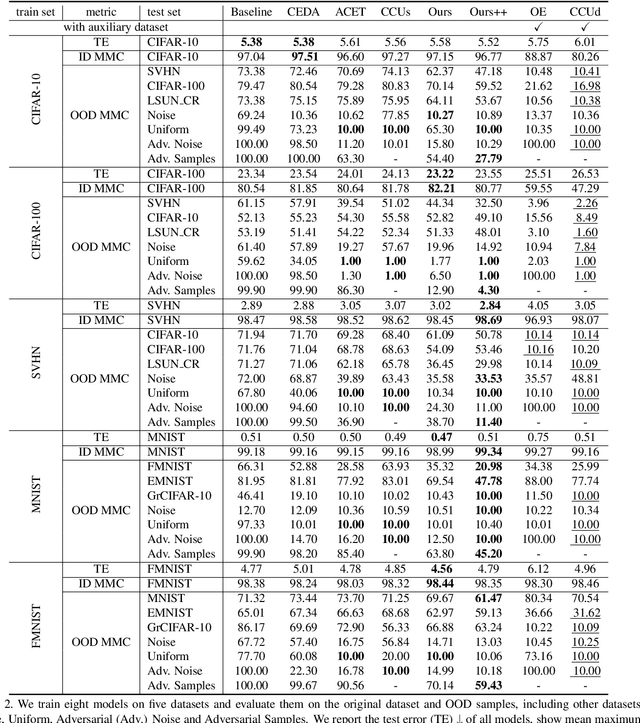Weilong Peng
School of Computer Science, Tianjin University
EOOD: Entropy-based Out-of-distribution Detection
Apr 04, 2025Abstract:Deep neural networks (DNNs) often exhibit overconfidence when encountering out-of-distribution (OOD) samples, posing significant challenges for deployment. Since DNNs are trained on in-distribution (ID) datasets, the information flow of ID samples through DNNs inevitably differs from that of OOD samples. In this paper, we propose an Entropy-based Out-Of-distribution Detection (EOOD) framework. EOOD first identifies specific block where the information flow differences between ID and OOD samples are more pronounced, using both ID and pseudo-OOD samples. It then calculates the conditional entropy on the selected block as the OOD confidence score. Comprehensive experiments conducted across various ID and OOD settings demonstrate the effectiveness of EOOD in OOD detection and its superiority over state-of-the-art methods.
Imperceptible Adversarial Attacks on Point Clouds Guided by Point-to-Surface Field
Dec 26, 2024Abstract:Adversarial attacks on point clouds are crucial for assessing and improving the adversarial robustness of 3D deep learning models. Traditional solutions strictly limit point displacement during attacks, making it challenging to balance imperceptibility with adversarial effectiveness. In this paper, we attribute the inadequate imperceptibility of adversarial attacks on point clouds to deviations from the underlying surface. To address this, we introduce a novel point-to-surface (P2S) field that adjusts adversarial perturbation directions by dragging points back to their original underlying surface. Specifically, we use a denoising network to learn the gradient field of the logarithmic density function encoding the shape's surface, and apply a distance-aware adjustment to perturbation directions during attacks, thereby enhancing imperceptibility. Extensive experiments show that adversarial attacks guided by our P2S field are more imperceptible, outperforming state-of-the-art methods.
CODEs: Chamfer Out-of-Distribution Examples against Overconfidence Issue
Aug 13, 2021



Abstract:Overconfident predictions on out-of-distribution (OOD) samples is a thorny issue for deep neural networks. The key to resolve the OOD overconfidence issue inherently is to build a subset of OOD samples and then suppress predictions on them. This paper proposes the Chamfer OOD examples (CODEs), whose distribution is close to that of in-distribution samples, and thus could be utilized to alleviate the OOD overconfidence issue effectively by suppressing predictions on them. To obtain CODEs, we first generate seed OOD examples via slicing&splicing operations on in-distribution samples from different categories, and then feed them to the Chamfer generative adversarial network for distribution transformation, without accessing to any extra data. Training with suppressing predictions on CODEs is validated to alleviate the OOD overconfidence issue largely without hurting classification accuracy, and outperform the state-of-the-art methods. Besides, we demonstrate CODEs are useful for improving OOD detection and classification.
B-spline Shape from Motion & Shading: An Automatic Free-form Surface Modeling for Face Reconstruction
Jan 21, 2016



Abstract:Recently, many methods have been proposed for face reconstruction from multiple images, most of which involve fundamental principles of Shape from Shading and Structure from motion. However, a majority of the methods just generate discrete surface model of face. In this paper, B-spline Shape from Motion and Shading (BsSfMS) is proposed to reconstruct continuous B-spline surface for multi-view face images, according to an assumption that shading and motion information in the images contain 1st- and 0th-order derivative of B-spline face respectively. Face surface is expressed as a B-spline surface that can be reconstructed by optimizing B-spline control points. Therefore, normals and 3D feature points computed from shading and motion of images respectively are used as the 1st- and 0th- order derivative information, to be jointly applied in optimizing the B-spline face. Additionally, an IMLS (iterative multi-least-square) algorithm is proposed to handle the difficult control point optimization. Furthermore, synthetic samples and LFW dataset are introduced and conducted to verify the proposed approach, and the experimental results demonstrate the effectiveness with different poses, illuminations, expressions etc., even with wild images.
 Add to Chrome
Add to Chrome Add to Firefox
Add to Firefox Add to Edge
Add to Edge